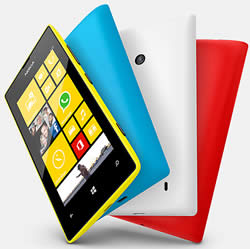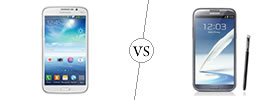Difference between LG Optimus L5 II, L5 II Dual and Nokia Lumia 520
Key Difference: The LG Optimus L5 II and its counter part LG Optimus L5 II Dual are two entry-level smartphones by the company. The LG Optimus L5 II and L5 II Dual are quite similar to each other but differ in certain places, including looks. The device comes with a 4-inch True IPS LCD capacitive touch screen that offers around 233 ppi pixel density. The Nokia Lumia 520 is a 4-inch IPS capacitive touchscreen smartphone that offers 480x800 pixels display, which offers approximately 233 ppi. The phone comes with 8 GB internal memory that can be expanded up to 64 GB. The phone offers 1 GHz on its dual-core snapdragon S4 and only 512 MB RAM, which is slightly disappointing.

LG has recently added a new phone series to its line-up. Following the original LG Optimus L series, the new phones include LG Optimus L3 II, LG Optimus L5 II and LG Optimus L7 II. The LG Optimus L5 II and its counter part LG Optimus L5 II Dual are two entry-level smartphones by the company. Although review websites say that the company has managed another miss, many users disagree and have enjoyed the phone specifically because of its cheap price.
The LG Optimus L5 II and L5 II Dual are quite similar to each other but differ in certain places, including looks. The Optimus L5 II has a bar format that has an oval hardware Home button on the front nestled right under the screen. This button is flanked by the Menu and Back capacitive buttons. The Optimus L5 II Dual, however, has four capacitive buttons Back, Home, Menu and the last button allows switching between the two SIM cards. The small design of both the phones is quite comfortable to hold and is also to use only with one hand. The buttons are also placed to make the device user friendly.
The power button is placed on the right side of the device, while the left side houses the volume rocker and a customizable button that is initially customized to Quick Note. The 3.5 mm jack is on the top of the device, while the USB charging port is on the bottom. The back of the device has the camera on the left side along with the LED flash on the bottom of it. The loudspeaker grille can be found on the bottom right corner. The company has given the back a ‘fake’ metallic look that can be passed of for a metallic back from far away. However, the back is made of plastic and has a little cheap feeling to it. The hardware Home button on the L5 II has LED behind it that illuminates while charging and also lights up different colors for different notifications.
 The device comes with a 4-inch True IPS LCD capacitive touch screen that offers around 233 ppi pixel density. The screen has decent resolution and clarity for the price. The phone is quite light and weighs around 103 grams for both models. Both the models come with Android 4.1.2 Jelly Bean out of the box and have been customized by Optimus 3.0 UI. The major difference between the two devices is the L5 II Dual’s ability to support dual SIM cards.
The device comes with a 4-inch True IPS LCD capacitive touch screen that offers around 233 ppi pixel density. The screen has decent resolution and clarity for the price. The phone is quite light and weighs around 103 grams for both models. Both the models come with Android 4.1.2 Jelly Bean out of the box and have been customized by Optimus 3.0 UI. The major difference between the two devices is the L5 II Dual’s ability to support dual SIM cards.
Both the devices are powered by 1 GHz single core processor, that results in lag if playing high-res demanding games. It also offers 512 MB RAM. The phones come with 4 GB internal storage capacity, of which only 1.75 GB is available to the user but, it can be expanded by 32 GB using a microSD card. The 1.75 GB still results in very less memory as Jelly Bean does not allow users to shift apps to the SD card. Both the devices come only with a 5 MP primary camera with a LED flash. The camera offers basic features such as geo-tagging, shot modes and a Cheese Shutter (that takes a photo when users say cheese). The camera also have VGA video taking capability.
The phone is powered by a removable Li-Ion 1700 mAh battery, which the company touts provides almost 10 hours of talktime on 3G network. The company has also provided with 50 GB of cloud storage and L5 II Dual offers a very cool feature known as On Screen Phone. This feature allows the phone to connect to a computer using USB or Wi-Fi, the user can then completely control the phone using the mouse and the keyboard. The application comes in the form of the phone on the screen and the user can also control the volume as well as the power buttons. The feature is a benefit for people that work on their computers continuously.
 Nokia is a Finnish cell phone company, well known for its superb battery power and durability of its phones, and is the only phone that has not yet integrated its smartphones with Android. Nokia has been single-handedly leading Microsoft Windows OS 8 in the smartphone market. Most of the smartphones have become a pricy accessory to own, and if people opt for a cheaper phone, they must sacrifice on some features. To make a mark in the low- to mid-range smartphone market, Nokia has announced the Lumia 520, which should be available in April 2013 in India (release dates for the rest of the world is yet unannounced) and is currently up for pre-orders on many websites. It has even reached to the second-spot following Samsung Galaxy Grand on the Indian website, Flipkart. The phone is a variant of its big brothers 820 and 920, minus some ‘flash’ features. The Lumia 520 is a 4-inch IPS capacitive touchscreen smartphone that offers 480x800 pixels display, which offers approximately 233 ppi. This is pretty good display screen for a mid-range smartphone.
Nokia is a Finnish cell phone company, well known for its superb battery power and durability of its phones, and is the only phone that has not yet integrated its smartphones with Android. Nokia has been single-handedly leading Microsoft Windows OS 8 in the smartphone market. Most of the smartphones have become a pricy accessory to own, and if people opt for a cheaper phone, they must sacrifice on some features. To make a mark in the low- to mid-range smartphone market, Nokia has announced the Lumia 520, which should be available in April 2013 in India (release dates for the rest of the world is yet unannounced) and is currently up for pre-orders on many websites. It has even reached to the second-spot following Samsung Galaxy Grand on the Indian website, Flipkart. The phone is a variant of its big brothers 820 and 920, minus some ‘flash’ features. The Lumia 520 is a 4-inch IPS capacitive touchscreen smartphone that offers 480x800 pixels display, which offers approximately 233 ppi. This is pretty good display screen for a mid-range smartphone.
The Lumia 520 is a bar phone with the straight sharp edges and is available with the standard Windows Tile layout. The phone comes with 8 GB internal memory that can be expanded up to 64 GB. The phone offers 1 GHz on its dual-core snapdragon S4 and only 512 MB RAM, which is slightly disappointing. Another let down is the lack of a secondary camera, which makes it difficult to video conferencing. The phone does offer a 5MP autofocus primary camera, with 4X digital zoom and no flash. However, the company claims to use the same digital lens that is found on the flagship. The camera offers features such as Landscape orientation, Auto and manual exposure, Auto and manual white balance, Cinemagraph lens and Smart Shoot lens. The smart shoot lens allows the user to change individual objects in the photo and replace them with objects from the other photos. For example: incase the user is taking photos of two people; however, he does not like the expression of one person in the photo, they can swap the face for another face from another photo. The phone is customizable with changeable shells. The phone has a monoblock casing with the sleep/wake button, camera button and volume buttons on the right-hand side of the phone. Nokia also offers the Windows Office, plus Nokia Music and Nokia Maps. The phone also offers many different features including 7GB free SkyDrive storage.
The information for the detailed table about the two phones has been taken from the LG website, Nokia website, techradar.com and GSMArena.com.
|
|
LG Optimus L5 II/ L5 II Dual |
Nokia Lumia 520 |
|
Launch Date |
April 2013 |
April 2013 |
|
Company |
LG Electronics |
Nokia |
|
Size |
L5 II: 117.5 x 62.2 x 9.2 mm L5 II Dual: 118.4 x 62.2 x 9.2mm |
119.9 x 64 x 9.9 mm |
|
Display |
4-inch True IPS LCD capacitive touchscreen |
4'' IPS LCD capacitive touchscreen |
|
Screen |
480 x 800 pixels (~233 ppi pixel density) |
480 x 800 pixels (~233 ppi pixel density) |
|
Protection |
- |
Scratch-resistant glass |
|
Weight |
103 grams |
124 grams |
|
2G Network |
GSM 850 / 900 / 1800 / 1900 |
GSM 850 / 900 / 1800 / 1900 - all versions |
|
3G Network |
HSDPA 850 / 900 / 1900 / 2100 |
HSDPA 900 / 2100 - RM-914 HSDPA 850 / 1900 / 2100 - RM-915 HSDPA 850 / 1700 / 1900 / 2100 - RM-917 |
|
4G Network |
N/A |
N/A |
|
GUI |
LG Optimus 3.0 UI |
Windows Phone 8 |
|
CPU speed |
1 GHz Processor |
1 GHz Dual-core Snapdragon S4 |
|
GPU |
PowerVR SGX531 |
Adreno 305 |
|
OS |
Android v4.1.2 (Jelly Bean) |
Microsoft Windows Phone 8 |
|
Chipset |
MTK 6575 |
Qualcomm MSM8227 |
|
RAM |
512 MB |
512 MB |
|
SIM Size |
L5 II: miniSIM L5 II Dual: Dual SIM |
microSIM |
|
Internal Memory |
4GB Internal (1.75GB User Available) |
8 GB |
|
Expandable Memory |
Up to 32GB |
Up to 64 GB |
|
Sensors |
Proximity, Ambient Light, Accelerometer, Digital Compass |
Brightness control, Orientation sensor, Ambient light sensor, Accelerometer, proximity |
|
Connectivity |
Wi-Fi, Browser, Bluetooth, PC Sync Application, USB, Modem Function, On Screen Phone, Video Streaming, USB tethering. |
GSM, WCDMA, Micro-USB, Bluetooth, Wi-Fi |
|
Data |
GPRS, EDGE, WLAN, Bluetooth, USB, NFC (L5 II) |
GPRS, EDGE, WLAN, Bluetooth, USB. |
|
Speed |
HSDPA, 7.2 Mbps; HSUPA, 5.76 Mbps |
HSDPA, 21.1 Mbps; HSUPA, 5.76 Mbps |
|
WLAN |
Wi-Fi 802.11 b/g/n, Wi-Fi Direct, Wi-Fi hotspot |
Wi-Fi 802.11 a/b/g/n, dual band |
|
Bluetooth |
Bluetooth v3.0 with A2DP, HS |
Bluetooth v3.0 with A2DP |
|
USB |
microUSB v2.0 |
microUSB v2.0 |
|
Primary Camera |
5MP AF Camera |
5MP, autofocus camera |
|
Secondary Camera |
N/A |
No |
|
Video |
VGA @30fps (640x480) |
720p@30fps |
|
Camera Features |
|
|
|
Sound Enhancement |
- |
None |
|
Audio supported formats |
MP3/ WMA / AAC / AAC+ / WAV / AC3 / AAC-LC, AMR-NB, WMA, WAV |
MP3, AMR-NB, WMA 10 Pro, GSM FR, WMA 9, AAC LC, AAC+/HEAAC, eAAC+/HEAACv2, ASF, MP4, AAC, AMR, MP3, M4A, WMA, 3GP, 3G2 |
|
Video supported formats |
MP4/ H.264 / H.263 / WMV |
MP4, ASF, WMV, AVI, 3GP, 3G2, M4V, MOV |
|
Battery Capacity |
Removable Li-Ion 1700 mAh battery |
Li-Ion 1430 mAh battery |
|
Talktime |
3G: 9 hours 54 minutes |
2G: 14.8 hours 3G: 9.6 hours |
|
Standby Time |
3G: 642 hours |
3G: 360 hours |
|
Available Colors |
Indigo Black, White, Pink, Titan |
Yellow, red, cyan, white/black |
|
Messaging |
SMS (threaded view), MMS, Email, Push Email, IM |
SMS (threaded view), MMS, Email, Push Email, IM |
|
Browser |
HTML5 |
HTML5 |
|
Radio |
FM radio with RDS |
No |
|
GPS |
A-GPS |
Yes, with A-GPS support and GLONASS |
|
Java |
Java MIDP emulator |
No |
|
Additional Features |
|
|
Image Courtesy: lg.com, nokia.com









Add new comment